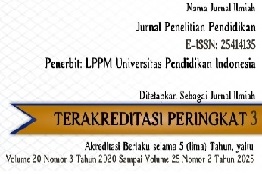Pengembangan Media Pembelajaran Bangun Ruang Sisi Datar Adaptif (BARUSIDA) Untuk Meningkatkan Pemahaman Konsep Siswa Tunanetra di Sekolah Inklusi
Abstract
Abstrak
Tujuan penelitian ini adalah untuk mengembangkan media pembelajaran geometri bangun ruang adaptif (BARUSIDA) yang valid, praktis, dan efektif dalam meningkatkan pemahaman konsep siswa tunanetra di sekolah inklusi. Media BARUSIDA adalah alat peraga nyata pada topik bangun ruang sisi datar yang didesain dengan memanfaatkan modalitas taktil siswa tunanetra, penulisan huruf Braille, serta dapat dibongkar-pasang seperti puzzle agar mereka dapat mengkonstruksi lebih dari satu jenis model bangun ruang sisi datar secara fleksibel. Metode penelitian yang digunakan adalah penelitian pengembangan model Plomp yang terdiri dari 5 fase, yaitu: (1) investigasi awal; (2) desain; (3) konstruksi; (4) tes, evaluasi, revisi; dan (5) implementasi. Penelitian ini dilakukan di SMP Modern Islamic School (MIS) sebagai salah satu sekolah inklusi yang melayani siswa tunanetra di Surakarta. Penelitian ini dilakukan secara terbatas pada 3 siswa tunanetra sebagai subjek penelitian dikarenakan kondisi pandemi Covid-19. Teknik analisis data untuk uji efektivitas adalah Single Subject Research dengan model Multiple Baseline Design tipe A-B. Hasil yang diperoleh adalah media BARUSIDA yang valid, praktis, dan efektif. Media BARUSIDA dinyatakan valid berdasarkan hasil validasi ahli. Media BARUSIDA dinyatakan praktis karena diperoleh tingkat keterlaksanaan media dan keinginan penggunaan media berada pada kategori Baik dan Sangat Baik dengan rerata skor angket respon guru sebesar 3,214, rerata skor angket respon dua orang siswa sebesar 3,2, serta rerata skor respon seorang siswa sebesar 3,5. Media BARUSIDA dinyatakan efektif karena terdapat peningkatan skor pemahaman konsep dari baseline ke treatment sebesar 1 sampai 3 poin setelah dilakukan beberapa sesi pertanyaan wawancara berbasis tugas terkait indikator pemahaman konsep.
Kata Kunci: Bangun Ruang Sisi Datar, Media Pembelajaran Adaptif, Pemahaman Konsep, Sekolah Inklusi, Siswa Tunanetra.
Abstract
This research aims to develop a valid, practical, and effective adaptive polyhedron learning media in geometry. The media is labeled as BARUSIDA. BARUSIDA is a real learning media in the form of concrete manipulatives on polyhedrons in geometry, designed by considering the tactile principles of visually impaired students. BARUSIDA can represent more than one type of geometry shape because it can be assembled flexibly like a puzzle so that visually impaired students can construct some solid geometry shape models. The method used in this research is development research which refers to the Plomp development model. The Plomp development model consists of 5 phases, namely: (1) preliminary investigation, (2) design, (3) construction, (4) test, evaluation, and revision, and (5) implementation. This research was conducted at SMP Modern Islamic School (MIS) as one of the inclusion schools serving visually impaired students in Surakarta. This research was conducted very carefully and was limited to 3 blind students due to the Covid-19 pandemic conditions. The results obtained in this research is valid, practical, and effective BARUSIDA learning media. BARUSIDA was declared valid after there were no comments or suggestions for improvement from experts after a series of expert validation processes had been carried out. BARUSIDA media is stated to be practical with the mean score of the level of media implementation and the desire to use media from the teacher’s response questionnaire of 3.214, the mean score of the two students’ questionnaire responses is 3.2, and the average response score of a student is 3.5. BARUSIDA media was declared effective with increased concept understanding scores from baseline to treatment, which ranged from 1 to 3 points after several sessions of task-based interview questions related to concept understanding indicators.
Keywords: Development Research, Manipulatives, Polyhedron, Concept Understanding, Visually Impaired Students, Inclusive Schools.
Keywords
Full Text:
PDF (Bahasa Indonesia)References
Anderson, Lorin W., (2001). “A taxonomy for learning, teaching, and assessing: A revision of Bloom’s taxonomy of educational objectives, abridged edition.” White Plains, NY: Longman 5.1
Andriyani, Budayasa, I. K., & Juniati, D. (2018). The blind student’s interpretation of two-dimensional shapes in geometry. Journal of Physics: Conf. Series 947, 1-6.
Argyropoulos, V. S. (2002). Tactual shape perception in relation to the understanding of geometrical concepts by blind students. British Journal of Visual Impairment, 20(1):7–16.
Aprilia, E. (2018). Pengembangan Media Pembelajaran Matematika Berupa Kotak Pop-Up pada Materi Bangun Ruang untuk Anak Autisme. Skripsi. Lampung: Universitas Islam Negeri Raden Intan.
Babai, R., & Lahav, O. (2020). Interference in geometry among people who are blind. Research in Developmental Disabilities, 96(1):1-12.
Buzzi, M. C., Buzzi, M., Leporini, B., & Senette, C. (2015). Playing with geometry : a Multimodal Android App for Blind Children. 11th Biannual Conference on Italian SIGCHI 134-137. Rome, Italy: CHItaly.
Cheah, U. H. (2010). Improving assessment in the primary mathematics classroom through lesson study. In Paper for the APEC-Chiang Mai International Conference IV: Innovation of Mathematics Teaching and Learning through Lesson Study-Connection between Assessment and Subject Matter (pp. 1-10).
Hartanti, I.W. (2017). The development of transparent solid geometry media to increase fifth grade students volume concept understanding at SDN Sumberpucung 03 Malang. Skripsi. Malang: UIN Maulana Malik Ibrahim.
Jhangiani, R. S., Chiang, I. A., & Price, P. C. (2015). Research Methods in Psychology Ch. 10 : Single-Cockett, A., & Kilgour, P. W. (2015). Mathematical Manipulatives: Creating an Environment for Understanding, Efficiency, Engagement, and Enjoyment. TEACH Collection of Christian Education, 1(1), 47-54.
Kwon, H., & Capraro, M. M. (2018). The Effects of Using Manipulatives on Students’ Learning in Problem Posing: The Instructors’ Perspectives. Journal of Mathematics Education, 11(2), 35-47.
Undang-Undang Republik Indonesia Nomor 20 Tahun 2003 pasal 5, dalam https://peraturan.bpk.go.id/Home/Details/43920/uu-no-20-tahun-2003, diakses 22 Januari 2021.
Lestari, K. E., & Yudhanegara, M. R. (2015). Penelitian Pendidikan Matematika. Bandung: PT Refika Aditama.
National Council of Teachers of Mathematics. (2000). Principles and Standards for School Mathematics. Diperoleh 22 Januari 2021, dari https://www.nctm.org/Standards-and-Positions/Principles-and-Standards.
Nisa’, Z. E. (2018). Pengembangan Media Pembelajaran Geoboard Berbasis Teori Belajar Van Hiele Pada Materi Pengenalan Bangun Datar untuk Tunanetra. Seminar Nasional Pendidikan FKIP UAD (hal. 43-54). Yogyakarta: Universitas Ahmad Dahlan.
Subagya. (2020). Pembelajaran Matematika dan IPA untuk Peserta Didik Berkebutuhan Khusus. Surakarta: UNS Press.
Van den Akker, J., Gravemeijer, K., McKenney, S., & Nieveen, N. (Eds.). (2006). Educational design research. Routledge.
DOI: https://doi.org/10.17509/jpp.v21i3.39328
Refbacks
- There are currently no refbacks.
Copyright (c) 2022 Jurnal Penelitian Pendidikan


